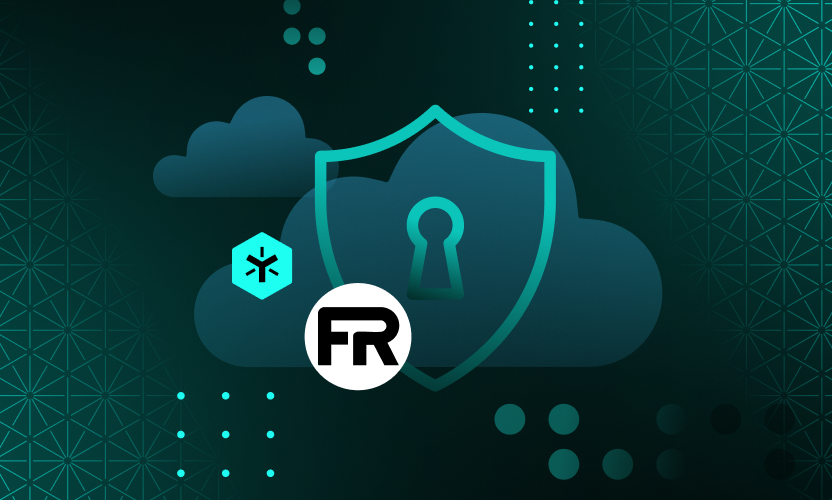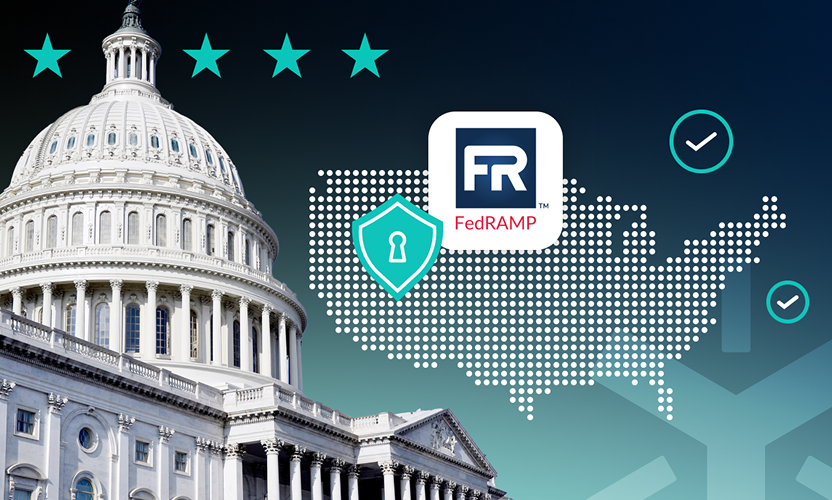
Egnyte’s Journey to FedRAMP Compliance and Beyond
Egnyte’s core values have always included trust, security, and enablement of business agility for customers who work in data-intensive and highly regulated industries. In turn, our cybersecurity program has always been aligned with those values, resulting in Egnyte’s maintenance and continuous expansion of our portfolio of industry-specific compliance certifications.
Over the 12 years of maintaining various compliance standards, we’ve built a resilient platform that’s served as a solid foundation to enable Egnyte to expand into the U.S. public sector space. It was due to the secure-by-design culture we’ve cultivated at Egnyte that we were able to deliver the EgnyteGov Platform at a reasonable cost, within an ambitious period.
Adapting the EgnyteGov Platform to Commercial Expectations
Deciding to pursue FedRAMP Moderate Equivalency and a presence on the FedRAMP Marketplace is bold for any Cloud Service Provider (CSP), especially when the platform infrastructure has been 15 years in the making and consists of hundreds of underlying microservices. But that’s exactly what we achieved.
The objective was to deliver the Egnyte Platform for the use of the U.S. Defense Industrial Base (DIB) and federal agencies. We already had a long list of Egnyte customers who belonged to the DIB and required a specialized secure data enclave that aligned with their CMMC requirements. The demand was real, and we knew a large group of DIB customers would deploy their operations into EgnyteGov as soon as the technical environment was available.
There was an important business caveat associated with the release of EgnyteGov: Existing customers of Egnyte Commercial had grown accustomed to its business workflows and their way of using the Egnyte Platform. They were willing to collaborate with us to work out the details, but we didn’t want to disrupt their business processes or introduce friction for their users. For that reason, we targeted a high level of capabilities parity between EgnyteGov and Egnyte Commercial Platforms from the outset.
Many Egnyte customers have domains in both environments, so we didn’t want it to be confusing for users when they work on their tasks in the Egnyte Commercial Platform or EgnyteGov. Therefore, we wanted as much consistency as possible between the two offerings. We were committed to achieving maximum convenience for end-users, while making that new environment fully compliant with the FedRAMP Moderate baseline.
Lean- And Nimble- Research & Development (R&D)
With functional requirements out of the way, we moved to strategic requirements for the project.
Egnyte is a lean and fiscally prudent organization that proudly manages an efficient R&D program. In that spirit, we recognized that delivering a project that results in long-lasting overhead and complicated processes is unacceptable, as these are major concerns if you’re not careful in designing and implementing FedRAMP controls.
Considering that new technical and procedural controls had made EgnyteGov a “special” environment, we needed to find ways to abstract away the new complexity, enabling Egnyte’s engineers to work efficiently across both Egnyte Commercial and EgnyteGov environments. We were not going to hire dedicated staff to operate EgnyteGov, and we couldn’t accept the productivity loss of having to retrain more than 400 engineers in new ways of doing things. Their day-to-day activities needed to remain smooth, and their transition between environments needed to be unnoticeable.
A Robust Foundation to Build Upon
To be clear, Egnyte had already implemented many of the NIST SP 800-53 controls (which serve as a foundation for the FedRAMP baseline) as part of our existing cybersecurity program, built upon multiple frameworks. Those frameworks include the Center for Internet Security (CIS) TOP 18, the NIST Cybersecurity Framework, the Cloud Security Alliance (CSA) CMM, the global ISO 27000 series, COSO Principles (SOC2), MITRE D3FEND MatrixTM, and MITRE ATT&CK© mitigation. You can find a comprehensive listing of Egnyte’s compliance standards here.
Even though we were familiar with most of the controls and always operated with robust governance principles, FedRAMP provided the framework to elevate our practice to the level of rigor. Many of the controls, be they technical or procedural, were well-known to our organization, but we needed to align our interpretation with FedRAMP Equivalency expectations, up-level our data governance, and become stricter with enforcement and continuous compliance monitoring processes across the board.
From a practical perspective, we had 325 controls to (re)design, (re)implement, and create/ improve monitoring of. We started by mapping the complete Moderate baseline to our Egnyte Unified Controls Framework, which is a customized controls map aligned with the frameworks that I referred to above. Then, during the gap analysis, we documented the delta that we needed to remediate to be fully compliant and estimated the cost for each control to adequately prioritize and staff technical execution.
Studying the nature of some of the control families, we mapped the controls that could be fully or partially inherited from a FedRAMP-authorized cloud provider. We deployed the EgnyteGov environment in the Google Cloud Platform (GCP), our comfort zone, because we already had more than eight years of experience securing Egnyte’s commercial platform in GCP. In addition, we learned the following during our prior FedRAMP Ready assessment: We should take maximum advantage of Google Cloud’s managed services, since they were already FedRAMP-authorized and reduced the in-house effort of bringing Egnyte’s services into a compliant status.
Many of FedRAMP’s controls require you to have an in-depth and intimate understanding of the mechanics that underpin the Infrastructure as a Service (IaaS) security capabilities that are available, as well as the limitations of your IaaS infrastructure. We’ve been fortunate with our experienced Cloud Security Team, because they possess that type of niche expertise, enabling us to get ahead of potential blockers and preventing sub-optimal architectural choices.
Although Google Cloud had a large portfolio of FedRAMP Authorized services, Egnyte utilized additional services in Egnyte Commercial that required separate management. We worked with our Engineering, DevOps, SRE, and IT teams to find substitute solutions for those mission-critical APIs and services. Along the way, we were also driven to make many important decisions about ongoing compliance costs.
Overall, deploying in GCP, taking advantage of authorized services, and GCP Assured Workloads allowed us to shave off a couple of dozen controls through controls inheritance, which allowed us to focus on building out controls that needed to be customized to Egnyte’s unique technology stack.
Tapping into Peer Companies’ Expertise
Even though NIST SP 800-53 is a pretty prescriptive framework, it leaves enough wiggle-room for you to have flexibility during the assessment process. Many controls can be implemented in different ways. And, depending on your unique technology stack and the way of work, you can spend a lot of effort trying to find the “perfect” solution that will eventually still miss the mark.
We run most of our workloads on Google Kubernetes Engine (GKE), interconnected with a significant footprint in Google Compute Engine (GCE), along with a wide range of self-hosted and managed services.
Egnyte deploys to production multiple times per week, and we have hundreds of services, some with different CI/CD architecture depending on the team that owns them. Egnyte has more than 1,000 global employees, including on-site and remote staff, with more than 22,000 businesses and a million users who rely on us each day. This boils down to the following: Egnyte is a global, agile, and cloud-native company with tremendous responsibility, so we can’t rock the boat and disrupt the well-oiled gears that keep our million-plus users productive. Due to the nature of our business model and the scope of several of the controls, the impact of FedRAMP-driven improvements went beyond EgnyteGov’s technical infrastructure to our commercial environment.
To be successful, we needed to consult with companies similar to ours that were in the process of obtaining their FedRAMP authorization or had already done so. We wanted to learn how companies that are as much (or even more) automation-heavy than Egnyte accomplished this, implement agile change management, and pioneer cutting-edge cybersecurity programs.
While working with assessors is beneficial, it’s a completely different level of conversation when you speak to boots on the ground colleagues, who have an intimate understanding of the inner workings of a software company. We needed success and failure stories from builders who were willing to share their war stories. Those conversations provided more perspective on what assessors had in mind and what they’re used to seeing when they validate the status of various controls. To some extent, we knew what assessors had in mind by working with several of them before, but that knowledge-sharing exercise allowed us to identify patterns and increase our likelihood of success accurately.
Ultimately, we’ve been able to pass the requirements while continuing to provide best-in-class user experience and a flexible platform for engineers to build upon. The minimal disruption to our business during our FedRAMP journey was possible thanks to the lessons we’d learned from our peers.
Leveling-Up the Partner Ecosystem
Similarly to the way our customers needed us to be FedRAMP Equivalent to pass their CMMC assessments, we need our partners and vendors to be at least FedRAMP Moderate Authorized to permit integration with the EgnyteGov ecosystem. For vendors we couldn’t use in the new environment, we opted to deploy self-hosted versions within the EgnyteGov authorization boundary, allowing us a level of control that was required to bring them into compliance with our requirements. If the vendor were a pure Software as a Service (SaaS) provider with no self-hosting option, we were forced to find an alternative that met the requirements.
Third-Party Assessment Organizations (3PAOs) and the FedRAMP Program Management Office (PMO) are very strict when it comes to cybersecurity supply chain risk management. Although there are types of systems that can have relaxed requirements, such as shared corporate services or services with a documented very low risk to the Confidentiality, Integrity and Availability of federal data, 3PAOs, and the FedRAMP PMO are concerned with metadata control, authorization boundaries, and Cloud Service Offerings as a whole.
Because the distinctions were not black and white, we tackled those areas early on with our assessors. If there were interconnections we had to take care of, the sooner we knew them the better, so we could find a resolution within the timeframe defined for our project. Taking action early also prevented us from wasting effort on replacing components that didn’t have to be replaced if sufficient compensating controls were put in place. That approach is vitally important for solutions like the Egnyte Platform that operate with a rich partner ecosystem and enable users to integrate their domains with third-party systems to enhance platform capabilities.
While evaluating new vendors, we increased our weighting criteria if the product or service could help us to achieve our compliance objectives in any way, such as by providing more detailed logging capabilities, user activity reporting, or advanced Role-Based Access Control (RBAC). One of the prominent changes we made was switching vendors for Software Composition Analysis (SCA) software to one that provided higher-fidelity detection capabilities, aided in building monthly Plans of Action & Milestones (POAMs), and was clearly built with the intention to empower heavy-duty cybersecurity and compliance programs. With security tooling, our goal was to have the tooling provide high-quality evidence with a documented audit trail for all risk adjustments, to take out as much subjectivity from the process as possible, and to utilize tools that assessors were more likely to be familiar with. The more a product or service could “defend itself” during the assessment process, the better for us.
Doubling Down on Zero Trust
At Egnyte, we’ve been implementing a zero-trust paradigm for infrastructure security since 2021, but FedRAMP allowed us to take it to a higher level. Through changes driven by EgnyteGov’s requirements, we’ve secured sponsorship to expand coverage of passwordless authentication. This includes FIDO2-compliant biometrics and hardware keys, context-aware access authorization, and service-to-service authentication. Additionally, we will further drill down on network microsegmentation across a significant number of services and applications.
Our implementation allows our on-site and remote employees convenient and safe access to corporate services, providing superior resilience against sophisticated attacks. Thanks to the upfront investment in building Software Development Kits (SDKs) in multiple programming languages, it’s easy for developers to plug new services into the framework and to benefit from a set of secure-by-design configurations. Application of a Zero Trust model allowed us to exceed the requirements of many otherwise complicated Access Control (AC), Identification & Authentication (IA), and System & Communications Protection (SC) controls, on top of the obvious boost to Egnyte’s overall security posture.
Continuous Compliance Excellence
After weeks of thorough assessments conducted by our 3PAO, we received an official letter of attestation, confirming that the EgnyteGov platform meets FedRAMP Moderate Equivalency requirements, with a very clean bill of health, including the Risk Exposure Table (RET) and Security Assessment Report (SAR). Existing EgnyteGov customers have further validated this, whose C3PAOs have reviewed Egnyte's technical documentation and determined that the documentation satisfies their CMMC assessment requirements.
Today, we have more than 100 customers leveraging the EgnyteGov Platform to achieve their business and compliance objectives. The FedRAMP Moderate Equivalency status of the EgnyteGov Platform significantly reduces the workload required to achieve a passing score on third-party CMMC assessments. The EgnyteGov Platform provides capabilities for customers to generate detailed documentation for multiple compliance frameworks. As a company that provides highly secure file sharing and data governance solutions, we utilize our expertise to aid our customers on their journeys through a wide range of compliance frameworks, including ISO 27001, GDPR, and the California Privacy Rights Act (CPRA).
This intense project led us to the next level of cybersecurity maturity, as we continue our security-first growth. The ultimate reward for our security team is realizing the business enablement of a new public sector vertical and a tangible improvement of the security ecosystem that underpins our Egnyte Commercial and EgnyteGov Platforms. As a by-product of delivering this project, we improved our security architecture to increase engineering velocity across the board, reducing time-to-market for new capabilities for all of our product lines.
Despite the excitement, we understand that work must continue. Implementing Equivalency requirements and achieving Equivalency status has opened a new chapter and unlocked new opportunities for our security organization to grow and improve. The upkeep of compliance, i.e., the Continuous Monitoring phase of the compliance lifecycle, will be critical to our continued success. As we introduce new capabilities into our platform, we involve our assessors to ensure all new releases meet the requirements of the strongest controls required by FedRAMP and that our platform continues to be the trusted choice for businesses working with the DIB and the U.S. Federal government.
While we strategize on the best next step, we’ll evaluate and implement more advanced controls to make our cybersecurity program ever stronger.
Maturing Our Cybersecurity Program: The North Star
At Egnyte, we don’t do compliance for compliance's sake. While obtaining the FedRAMP Equivalency status is a regulatory requirement necessary to provide our services to the public sector and DIB, it was essential that we do it right. The North Star has been to mature our cybersecurity program and product infrastructure by meeting or exceeding control requirements, to the point where the FedRAMP assessment becomes a formal testament to the robustness of our platform. We want companies to partner with us because they trust that their most-sensitive data is safe with Egnyte and, in addition, that we meet their compliance requirements. And that’s exactly how we executed this project. This ruthless pragmatism and iterative process of designing and implementing controls were demanding; however, they resulted in increased governance maturity for the entire company. As of August 2025, we’ve back-ported more than 50% of the controls improvements made for EgnyteGov into our commercial environment to similarly improve its cybersecurity posture.
Take-Aways for Peers Pursuing FedRAMP Compliance
Embrace outside expertise
To increase your level of confidence, I strongly recommend working with a 3PAO, consultants, and in-house professionals who have been through the FedRAMP process before. Each infrastructure is unique, so there are very few cookie-cutter solutions when it comes to meeting FedRAMP requirements. Even if you’ve already achieved your ISO 27001, COSO Trust Principles, or PCI-DSS requirements, you should still brace yourself for the complexity and level of effort required for FedRAMP.
FedRAMP isn’t only for your security team
It’s a commitment of the whole organization, and sponsorship is required from top-most executive leadership. Every employee in the organization plays a part, and multiple teams will be required to allocate a significant amount of capacity to implement and sustain the new controls. Do not underestimate the challenge and don’t downplay the effort while selling it to other team leaders. Everyone needs to be educated on the impact FedRAMP compliance will have on them, not only for the next few quarters as they work through the equivalency and/or authorization, but also for years to come as long as the company intends to remain compliant.
Discipline and clarity go a long way
FedRAMP will take a significant toll on your security, compliance, and engineering teams. With everyone already busy with their standard workloads, you want to ensure every task you delegate is well-documented and clear, particularly when it comes to the priority of the items on your project backlog. The unknown breeds frustration, as very few people outside of security teams can understand the compliance lifecycle or translate raw control requirements into actionable tasks.
Learn More
To learn more about the final steps your organization needs to take to prepare for its CMMC assessment, watch and share our recent webinar. And, click here to review Egnyte’s listing on the FedRAMP Marketplace.




